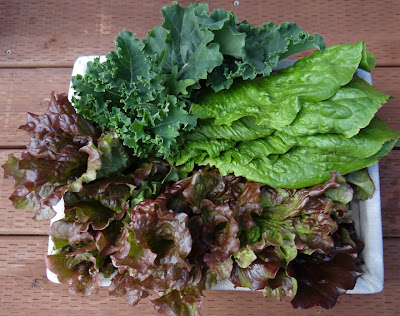 |
| Three types of radishes, from seeds, harvested June 19th. Left: Cherry Bell; Center: French Breakfast; Right: Amethyst Hybrid. French Breakfast were old seeds and most didn't grow. |
We planted earlier this year, mid-April (rather than last year's late-May), which means we're already harvesting lettuces, radishes, spinach and kale, despite more rain and cooler temps than usual this spring.
Back-track to the end of April...
 |
| Lettuce starts, April 27th |
We purchased lettuce starts (three types this year) from Brown's nursery in mid-April.We'll be feasting on fresh, home-grown lettuce all during May, June and into July.
The weather turned really nasty right after planting our starts this year, so Robin bought paper cups (waxed), cut the bottoms off, and squished them into the dirt like collars around each of the starts. Our hope was to protect the starts from the harsh spring winds and super cold night temps. Mixed reviews about the cup strategy... the starts might have done fine without them and getting them out of the dirt a month later was tricky, as the dirt stuck to the cups and disturbed the plant roots during the removal process. Plan for next year? Plant the starts a few weeks later and forget the cups.
 |
| Spinach, lettuce and beets, April 27th |
We also planted spinach starts at the same time, and were eating baby spinach greens by early May. The spinach started to go to seed in June, needing to be removed by the end of June. We had a lot of tasty spinach from one little flat of starts for about $2.00!
 |
| Three types of lettuce, plus kale, harvested on June 19th |
We started radishes, beets, kale and carrots from seed, all planted directly in the troughs at the end of April, except for the carrots, which weren't planted until the night temps were higher (early June). All are doing well. The lettuce & kale harvest above was on June 19th.
 |
| Zucchini and tomato starts in the garden shed. |
Robin bought zucchini and tomato starts (from the grocery store) at the end of March. We kept them in our garden shed, re-potting them on May 4th as they got too big for the 3" pots. We planted them outside in the garden at the end of May.
 |
| Installing Lunnette's sign above the garden shed door. |
Robin's friend, Lunnette, painted a beautiful sign for the garden shed, which as you can see, I promptly installed! Now the garden shed is complete.
 |
| Garden art! |
Oh, one more thing, new this year! Anyone who knows me, will certainly peg me as a collector of rust. Some time I'll post pictures of a few of my favorites. This spring, my friend, Rick Waldron, unearthed a gloriously rusted farm implement on his property. Now it's my new "garden art!"
I'll write another post, later, about our potatoes.













































